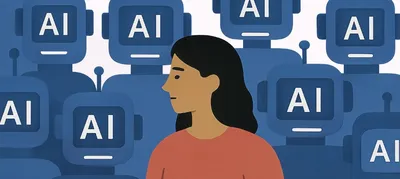Mission meets machine, but how do we align AI with our values?
AI is already reshaping the nonprofit landscape, but how do you adopt it without losing what makes your work human?

There’s no more “waiting to see” with AI. It’s here, it’s moving fast, and it’s already reshaping how nonprofits communicate, deliver services, and fundraise. From AI-powered donor segmentation to content generation, chat-based support, and even data-driven program design, the tools are not only available, they’re increasingly embedded in the platforms many organizations already use.
And yet, for many nonprofit leaders, AI still feels like foreign terrain. The ethical stakes are high. The use cases are murky. And the pressure to act quickly is often matched by a deeper instinct: to protect the mission.
That instinct is right. Because while AI can unlock meaningful efficiencies and new forms of impact, it also risks disconnection — from users, from values, and from the very communities you serve. The opportunity isn’t just to adopt AI. It’s to adopt it well — with clarity, purpose, and care.
From productivity to purpose
Most conversations about AI start with automation. And to be fair, that’s where a lot of the early benefits are showing up — summarizing meeting notes, speeding up content workflows, triaging emails or support requests.
But for mission-driven organizations, the real value of AI lies further upstream.
How can machine learning help you identify unmet needs in your community faster? How might a chatbot help reduce barriers to access for clients who aren’t comfortable picking up the phone? What if AI could help personalize supporter journeys in a way that actually increases trust and engagement — rather than eroding it?
These aren’t just productivity questions. They’re strategic ones. And answering them well requires more than just a working knowledge of AI tools. It requires a clear sense of your values — and a willingness to explore where those values intersect (or clash) with emerging technologies.
The value of slowing down (briefly)
Torchbox recently supported Breast Cancer Now, the UK's leading breast cancer charity, through an AI discovery process that brought together staff from across the organization — including researchers, fundraisers, and people with lived experience. Together, we explored how AI might be applied across content, operations, and support services.
What made the process successful wasn’t just the identification of 134 potential use cases. It was the intentional, participatory approach. Teams had space to interrogate assumptions, explore risks, and surface ethical concerns early — not just as an afterthought. That process uncovered use cases with real transformative potential: not just “efficiency plays,” but tools that could improve care, strengthen personalization, and free up human time for where it matters most.
Too often, nonprofits are told to rush into AI adoption or risk falling behind. But a short period of strategic reflection can create the clarity needed to move forward with confidence — and avoid unintended harm.
The risk of silent drift
There’s a quieter risk facing nonprofits in 2025 — not overuse, but drift. As platforms like Google, Microsoft, and Meta bake AI deeper into their tools, nonprofits may find themselves using generative AI without realizing it. Automated captions, AI-written headlines, predictive targeting — they’re already in the stack. And unless your team is asking the right questions, it’s easy for your message, tone, or even targeting logic to start shifting without oversight.
That’s why alignment needs to be intentional.
Ask: Who’s reviewing AI-generated content before it goes live? What data is being used to train internal models? Are you reinforcing equity — or bias — through how your automations operate? These aren’t theoretical questions. They’re governance decisions. And the nonprofits that get ahead of them now will be better positioned to build trust, not erode it.
Three lenses for ethical AI adoption
- Impact: Will this use of AI help us achieve our mission faster, more fairly, or more effectively?
- Integrity: Does it align with our values, especially in how it treats people, data, and truth?
- Inclusion: Who is at risk of being left out — or harmed — if we implement this? How can we mitigate that?
One of the most important lessons from the past year is that the best AI use cases are rarely imagined by senior leadership alone. They come from conversations — across teams, with communities, and through experimentation.
In fact, during the Breast Cancer Now discovery sprint, it was often people with lived experience who proposed the most imaginative, values-driven uses of AI — from personalized clinical guidance to community support matching.
That’s why “readiness” isn’t just about tech skills. It’s about culture. A culture where people feel safe to ask hard questions. Where small experiments are encouraged. Where impact and inclusion are prioritized over speed.
Because AI will change how nonprofits work. But the best ones won’t let it change why they work.
Explore AI with purpose
We can help you explore real AI use cases that match your mission, evaluate risks, and identify a high-impact place to start. You’ll come away with a clear snapshot of AI readiness and top opportunities to explore safely.



